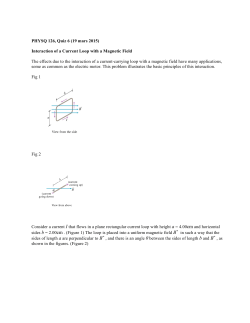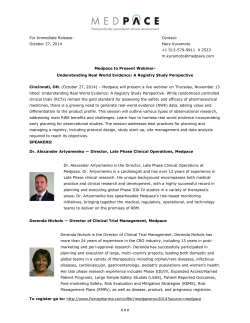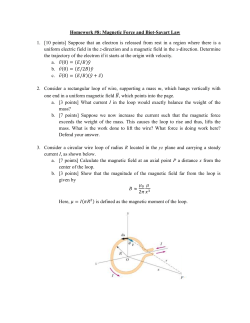
Problem Set 4: Principles of Feedback Control
ELEC 3004 / 7312 – Digital Linear Systems: Signals & Controls 2015 Problem Set 4: Principles of Feedback Control Total points: 100% Due Date: Tuesday, June 2, 2015 (at 11:59pm, AEST) 2 Note: This assignment is worth 12% of the final course mark. Please submit answers via Platypus . It is requested that solutions, including equations, should be professional and typed only. The solution content must be within the solution, externally linked materials are not acceptable. The final grade is the median of the marks from the peer reviews and the staff (with provisions for review). Finally, the tutors will not assist you unless there is real evidence you have attempted the questions. As a friendly reminder, please check Casper and address emails to elec3004@itee.uq.edu.au . Thank you. :) Questions Explain your solutions as if you are trying to teach a peer . Demonstrate your insight and understanding. For all questions, please justify your solutions . Answers alone are not sufficient. At all times please (note: remember to justify your solution). Answering an entire question with bare equations, lone numbers or without any verbal explanation is not acceptable. Although a rubric will be provided to guide peer marking, peers may reduce marks if they believe an answer is of poor quality, demonstrates little effort or significant misunderstanding. Furthermore, if a solution demonstrates understanding in a way not anticipated by the rubric, peers may also award higher marks than would be awarded by strict adherence to the rubric. In other words, you are free to use your judgment when marking your peers. Please explain and show reasoning/work . (as in any University course, answers alone are not sufficient). Q1. A Little Unit of Feedback [10 %] Consider a unity, negative feedback systems with the following open loop transfer function: 10 G(s) = s+1 Determine the output ( y(t) ) for the following reference inputs: a. r(t) = sin(t) b. r(t) = cos(t) c. r(t) = sin(t) − cos(t) d. r(t) = sin(t) + cos(t) Hints: ● Note that the reference inputs, r(t) , and requested outputs, y(t) are in the time domain, but that the plant is in the sdomain, It might help to convert r(t) to the Laplace domain first. ● The feedback path (often indicated as H(s)) is unity ● In determining the solutions to parts (b) through (d), you may reference to solutions from previous part (a) through (c). However, answers have to be clear and justified. ⇒ [ Updates (19/5): ● Added in ‘negative feedback’ to clarify type of feedback 1 Q2. Concepts: Loop Gain [10 %] Consider the following closedloop, negative feedback controller in the sdomain where C(s) is the controller, G(s) is the plant, H(s) is the sensor, R(s) is the reference signal, E(s) is the error, TE(s) is the tracking error signal T E(s) = R(s) − Y (s) (not shown) , D(s) is the disturbance signal and N(s) is sensing noise. For such a system, we can define the Loop Gain , L(s) : L(s) = C (s)G(s)H(s) In this, please consider and discuss: a. For the unity feedback case ( where H(s) =1 ), show that the tracking error, which we define as T E(s) = R(s) − Y (s) (not to be confused with E(s)), is: R(s) L(s)N(s) T E(s) = 1+L(s) − D(s)G(s) 1+L(s) + 1+L(s) b. Does a large loop gain, L(s), increase or reduce the influence of a disturbance, D(s), to the tracking error ( TE(s) )? Why? c. Does a large loop gain, L(s), increase or reduce the influence of noise, N(s), to the tracking error ( TE(s) )? Why? d. Reflecting on the results from above, how does this suggest we should shape L(s) as a function of frequency? Why? Please be analytic, specific and clear in your explanation. Waffling will not be accepted. ⇒ [ Update (18/5): Tracking error ( TE(s) ) notation added to help clarify this and note it as distinct from the feedback loop error ( E(s) ). Even if one solves for E(s) the trends being considered remain the same ] ⇐ 2 Q3. Mind The Step? [20 %] Please consider the steady state error ( e ) of a negative, unity feedback control process ss under the following inputs R(t) (step, ramp, and parabola) for Type 0, I, and II plants and output Y(t) . Thus, the Question: With this in mind, please determine the following: a. For a step input of magnitude K, determine the steady state error for a Type 0, I, and II system. (Please remember to show your working) b. For a ramp input of magnitude K, determine the steady state error for a Type 0, I, and II system. (Please remember to show your working) c. For a parabolic input of magnitude K, determine the steady state error for a Type 0, I, and II system. (Please remember to show your working) d. Using the results from above, please present a summary table of steadystate errors such as: Input Type System Step Ramp Parabola Type 0 ∞ I II Hints: ● More so than the answer to the table in Part (d), we are interested in your reasoning and process. Be sure to justify your answer. ● ess = limt→∞ e(t) = lims→0 s∙E(s) (as per the final value theorem) Note that: ● A Type n plant refers to the number of integrators in G(s) a a (eg, the system G(s) = s+b is a Type 0 plant1, but G(s) = s(s+b) is a Type 1 plant) ● A step input of magnitude K may be considered as r(t) = K or r(s) = Ks ● A ramp input of magnitude K may be considered as r(t) = K t or r(s) = sK2 2 ● A parabolic input of magnitude K may be considered as r(t) = Kt2 or r(s) = sK3 ● For convenience we may define the following steady state errors o P : steady state position error, P = lims→0 G(s) o V : steady state velocity error, V = lims→0s G(s) o A : steady state acceleration error, A = lims→0s2 G(s) ⇒ [ Updates (19/5): ● Fixed typo in the first sentence. Please solve for Type 0, 1, & 2 Plants ● Fixed Typo should be G(s) (Note 1 said C(s)) ● Clarified plant type by providing example of Type 0 and I plants. ● Clarified notation to prevent confusion with Question 2 (which is different) ] ⇐ 1 The system type is different to system order. A system is called Type 0,I,II, etc. if N=0,1, 2,... respectively as given in G(s)=[K(T • s+1)(T • s+1)...(T • s+1)] / [ s^N (T • s +1)(T • s+1)...(T • s+1)] a b m 1 2 p 3 Q4. PID’s New PID? [20%] Universal Questocopter (UniQuest) seeks your advice on whether they should patent and license the following control circuit presented to them by Dr Ahab of Pequod Industrial Design. He claims to have invented a new PID controller using an integrator and a firstorder lag controller as follows: Is Dr Ahab correct? (i.e. is this a “leadlag compensator”)? Should UniQuest patent this? E (s) Let’s investigate this by determining the transfer function C (s) = Eout for this circuit in(s) a. What is the impedance of Z and Z ? 1 2 E(s) b. What is E (s) ? in E (s) out c. What is E(s) ? d. Now consequently what is the transfer function for the entire system as a function of R , R , R , R , R , C and C ? 1 2 3 4 5 1 2 R5 e. It’s claimed that ratio R4 adjusts the overall gain of the controller. Is this correct? 4 Q5. In Step and Out of Step with Ziegler and Nichols [40%] 2 In 1942, Ziegler and Nichols empirically derived two methods to help tune PID controllers: ● The transientresponse [aka “first method” or “openloop Ziegler and Nichols”], and ● The stabilitylimit [aka “second method” or “closedloop Ziegler and Nichols”]). Of this, let us consider the performance of the TransientResponse Method for a standard 1 negative feedback control case where C (s) = K P (1 + T Is + T Ds) : Recall that the first method is particularly apt for systems that can be approximated as a −Ls firstorder plant having a transport delay ( L ) and rise slope (K/τ) , thus G(s) = Ke τs+1 Step I: Simulation Let us simulate the influence of the parameters K , L and τ . For K=[1, 5, 10 and 100], L=[1, 5, 10 and 100] and τ=[1, 5, 10 and 100] , please write a program to: (1) Determine K , T and T (as needed) for e ach of a P, PI and PID controller; and P I D Y (s) (2) Plot the output response ( R(s) ) of each of these three case to a unit step. For K=10 and L=[The last digit of your student number]+1 , present your results against the variations in τ . Notably, please present: (a) the resulting values for K , T and T in this case P I D (b) P, PI, and PID step response plots (against time) Step II: Analysis Clearly, the ZieglerNichols method will not work with all plants and processes. Using the results from the simulation (Step I), fully discuss the nature and limitations of this approach (in other words where does it work well? and where does it fail? ). Some points to consider: ● The “first method” requires taking the controller ( C(s) ) outoftheloop (hence the term “openloop”). Discuss the benefits and disadvantages of this. ● The average decay ratio (in general, on the whole), is it the ¼ decay expected? ● What would happen if there is measurement noise? ● Applicability of this approach to processes with a large L/τ (eg, L/τ=10) ● Applicability of this approach to processes with multiple latencies/time lags ● [Optional – though required for a HighDistinction mark on this question] Considering that ZieglerNichols was designed to provide the best disturbance rejection instead of the best input response performance, describe an “improved ZieglerNichols” method that would focus on the latter (i.e., step response). J. Ziegler, N. Nichols. “Optimum settings for automatic controllers,” Trans. ASME , 64:11 (1942). 2 5 Attaching commented code: Please attach your fully documented code that can generate the values and plots for the general simulation case (ie, K=[1, 5, 10, 100], L=[1, 5, 10, 100], τ=[1, 5, 10, 100]). It is expected that the code will be written to a “professional standard”. Hints: ● The program may be in any language of your choosing, but the tutors typically support MATLAB. ● Consider the Matlab step command documentation ● In (b) please show time on x axis and normalized magnitude on the y axis. ● One way to present part (b) is to have 3 plots (one each for the P, PI, and PID control architecture) and each plot would show 4 step responses (for one values of τ=[1, 5, 10 and 100]). Another way to show this is to have 4 plots (one each for the values of τ) with each plot in this case showing 3 responses for the (P, PI, and PID architectures) ● In general simulation the code will generate a considerable amount of results. We are only asking for a subset of these results to be presented. Please do not plot the results for all cases; kindly only the cases requested in Step I or those you wish to include as part your explanation in Step II. 6
© Copyright 2025









